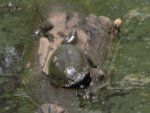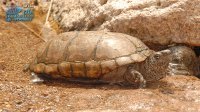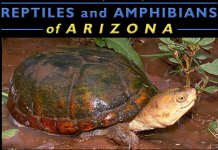| Range: |
 |
| Other Names: |
|
| Description: |
A small (shell up to 175 mm or 7" in length ) turtle with an olive or gray-brown, dome-shaped shell. The top part of the shell (carapace) has three mild lengthwise keels. The underside of the shell (plastron) is usually yellow-brown and has two hinges so that the front and back can close when the turtle retreats inside. There are small, fleshy projections on the throat. The head and neck are marked with yellow or cream colored reticulations on a dark olive background. The feet are webbed. The markings on the head and neck distinguish this turtle from our other mud turtles. |
| Similar Species: |
The Yellow Mud Turtle is most similar but doesn't having a strongly mottled head. The Snapping Turtle has a very small cross-shaped, unhinged plastron. Painted, sliders (Pond and Big Bend) and Cooters have large unhinged plastrons. The Box Turtle has a plastron with a single front hinge. |
| Habitat: |
Usually found in rocky streams, creeks, and rivers. It also inhabits ponds, cattle tanks, and ditches. |
| Behavior: |
Primarily diurnal in spring and fall but can be active at any time of the day or night during the hot summer months. It is aquatic but often travels overland between bodies of water. When captured or threatened it may emit a foul smelling musk from glands on the sides of the body. |
| Hibernation: |
During the cold months of late fall and winter it hibernates in the soil under the water or in cavities along the bank. |
| Reproduction: |
This turtle mates in the water during spring and lays a clutch of up to 11 brittle-shelled eggs in an underground nest.
|
| Diet: |
The Sonora Mud Turtle is primarily carnivorous. It feeds on insects, snails, fish, frogs, and carrion. It may also eat some plant material. |













